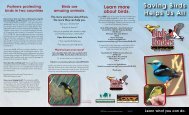Bonobo - Zoological Society of Milwaukee
Bonobo - Zoological Society of Milwaukee
Bonobo - Zoological Society of Milwaukee
You also want an ePaper? Increase the reach of your titles
YUMPU automatically turns print PDFs into web optimized ePapers that Google loves.
A Flutter <strong>of</strong>Color<br />
The Julia is a brilliant<br />
orange gem against<br />
green. Photo by Craig Berg<br />
The postman butterfly draws<br />
attention with its lipstick-red spots.<br />
Butterflies! In Living Color<br />
Sponsored by Sendik’s Food Markets<br />
Special indoor summer exhibit<br />
May 28-Sept. 25<br />
Otto Borchert Family Special Exhibits Building<br />
$2 per person<br />
Free Days: <strong>Zoological</strong> <strong>Society</strong> members get in free<br />
to the exhibit on June 7, 8 and 9 from 3 p.m. to 8:30 p.m.,<br />
with Zoo Pass card and photo I.D.<br />
Avoid: insect repellent; it can kill butterflies.<br />
The eastern tiger swallowtail<br />
has marvelous camouflage.<br />
Step into a world <strong>of</strong> reds, oranges, yellows, greens,<br />
blues and purples. At the <strong>Milwaukee</strong> County Zoo this<br />
summer, your eyes can feast on a canvas <strong>of</strong> colorful<br />
butterflies in the special exhibit Butterflies! In Living<br />
Color, sponsored by Sendik’s Food Markets. As you<br />
tour this indoor exhibit, you may wonder: Why so<br />
much color?<br />
It turns out that color can be bewitching. Some<br />
butterflies use their bright colors to attract mates.<br />
Although coloration in most butterfly species is the<br />
same in males and females, males <strong>of</strong> the common<br />
blue butterfly species exude an electric blue pigment<br />
while the females are varnished in a dull shade <strong>of</strong><br />
brown. Females seek out the males, lured by their<br />
bolder coloration. Anna blue butterflies are very similar.<br />
While the top surface <strong>of</strong> the male’s wing features<br />
a s<strong>of</strong>t blue hue, the female appears much browner.<br />
This follows a trend in blue butterfly species. The<br />
males are <strong>of</strong>ten more brilliant to draw the attention<br />
<strong>of</strong> females.<br />
Colors also serve as protection. Many butterflies<br />
such as the monarch and queen taste foul to predators,<br />
and some butterflies are even toxic. So their rich<br />
coloration warns predators that they’re inedible (see<br />
Kids Alive, page 12).<br />
While butterfly color is certainly linked to its<br />
survival, other factors like habitat influence this<br />
insect’s ability to succeed in the wild. Butterfly habitats<br />
are <strong>of</strong>ten threatened, altered or completely<br />
destroyed thanks to both people and changing environments.<br />
For example, as a caterpillar, the Karner<br />
blue butterfly feeds on lupine, a plant primarily<br />
found in prairies. As forests have invaded nearby<br />
prairies, lupines have died <strong>of</strong>f. “Once prairies disappear,<br />
lupines disappear and Karner blue butterflies<br />
disappear right along with them,” says Craig Berg,<br />
the Zoo’s aquarium and reptile curator (including<br />
insects). As farmers replace butterfly plants with<br />
crops and spray them with pesticides, says Berg,<br />
“they eliminate butterfly habitat and poison their<br />
habitat.” When these insects feed on plants polluted<br />
by pesticides, they die. The Karner blue is federally<br />
listed as endangered, but the species has a stronghold<br />
in Wisconsin because the state has done a pretty<br />
good job <strong>of</strong> protecting prairies, says Berg.<br />
The Zoo’s special exhibit will feature butterflies <strong>of</strong><br />
North America. Some may be new to you. “You’re<br />
going to see a lot <strong>of</strong> species not found in Wisconsin,”<br />
Berg notes. “Many <strong>of</strong> them also can be found in the<br />
Caribbean,” where Berg and other Zoo staff have been<br />
doing research on frogs, snakes and iguanas. Learn<br />
about some <strong>of</strong> that research near the entryway <strong>of</strong> the<br />
butterfly exhibit. Afterward, get in more color as you<br />
visit the Zoo’s four outdoor butterfly gardens: 1) in<br />
front <strong>of</strong> the Otto Borchert Family Special Exhibits<br />
Building, 2) in the Northwestern Mutual Family Farm<br />
near the railroad tracks, 3) in the farm near the Bee<br />
Exhibit, and 4) next to the Dall sheep exhibit.<br />
By Erica Breunlin<br />
Web: Butterfly data: butterfliesandmoths.org Alive Spring-Summer 2011 11













